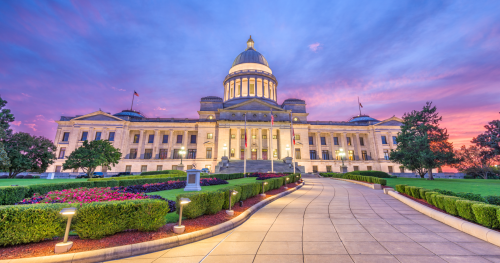America is in the opening stages of its next infrastructure decade. The Infrastructure Investment and Jobs Act (IIJA) and Inflation Reduction Act (IRA) will channel hundreds of billions of federal dollars into state and local infrastructure, representing the largest transfer of federal funds to state and local governments in generations and the most significant impact on the spatial design of urban and rural regions since the interstate highway era of the 1950s. Infrastructure building and rebuilding at this scale can transform economies, social connections, and a community’s quality of life.
This unique investment environment suddenly brings a little-discussed governing tool into the spotlight: the capital budget. Capital budgets are the formal legislative documents that state and local governments use to identify projects and funding sources for the fixed assets that generate long-term economic returns, create financial liabilities, and represent promises to the community, such as roads, bridges, water, wastewater, transit, and broadband. Each government uses slightly different terminology and follows slightly different rules, but these budgetary documents are used in every place.
Considering the enormity of this historic moment, elected officials, government officials, civic leaders, and even voters need to understand how capital budgets work: who controls them, where their fragilities lie, and how to maximize their potential to positively transform the economic and social trajectory of a region.
Capital budgets shape states and metropolitan regions
In practical terms, one can think of a capital budget as a guide to future cityscapes. The bridges in cities with hills and harbors, such as Pittsburgh and San Francisco, give a physical feel and sense of place to the region. Highways and cloverleafs mark the views of Dallas, Chicago, and Los Angeles. In the absence of such massive public investments, cities would look, feel, and behave differently. That is to say, the capital budget is a much more formidable and lasting document than an annual current expense or operating budget that funds the day-to-day operations of government service delivery, because it sets the future direction, evolution, and potential of a city or region.
Infrastructure investments are typically funded through a government’s capital budget by way of its capital improvement fund (CIF). The CIF receives its fiscal resources from three primary sources: own-source revenues (what the government raises through taxes, fees, and fines); federal funds (such as those from the IIJA); and bond funds (aka, borrowed money). The projects that make it into a capital budget are what will define the future of a region.
Cities and states understand that images of the built environment or an iconic cityscape are long-lasting (hence the name “fixed asset”). Once constructed, a facility is likely to survive for decades, shaping the physical contours of a city’s design. Infrastructure built by public authorities is the foundation of great cities. And infrastructure that is designed to separate and divide also has lasting impacts by reducing a city’s potential. For example, a contemporary project in Kansas City, Mo.—supported by a federal RAISE grant—is designed to mend a neighborhood divided by a highway built decades ago by considering pedestrian overpasses. This approach of not dismantling the fixed asset (US 71) but working around it is an explicit recognition that once infrastructure is built, it defines the immediate area and leaves an indelible spatial print.
The cost of a fixed asset exceeds the published cost in the capital budget
Capital budgets reflect the cost of construction, renovation, and major repairs of a fixed asset. However, the published or contracted cost is only a fraction of the total spending on a specific asset. Much like a household’s decision to buy a home, monthly mortgage payments cover only a portion of the full cost of the dwelling. Insurance, structural issues, appliance repairs, and variable utility costs all add to the final cost of a home’s useful life.
In a similar vein, the financial liabilities for a city, county, or state’s budget often reflect only the actual construction or renovation costs, not the longer-term repair, replacement, and other maintenance costs of the asset. The actual “price” of an asset, then, should be reconceptualized as its construction costs (which can be found in the capital budget) plus the amortized value of all future operations and maintenance costs (which can be found in the operating budgets over the useful life of the asset).
The preponderance of repair and maintenance costs are funded not from the capital budget, but the operating budget—and that typically leads to problems. City councils, county boards, utility commissions, and other legislative bodies rarely consider capital and operating budgets at the same time, and capital projects frequently extend beyond one fiscal year. Formal rules also don’t always require local or state government officials to consider future multiyear operational costs when approving projects within their capital budgets. When they are considered, the required maintenance funds are almost never directly linked to a specific project, in part due to the long useful life of capital projects. In other words, capital budgets are almost invariably approved without a crosswalk between the capital budget’s listing of individual projects and their repair and maintenance costs within the operating budget.
The net result is a federalist government system set up to reward ribbon cuttings and delay maintenance for another day. Civil engineers and project managers know exactly how much assets will cost to build and maintain; they can even predict how many decades the asset might last. But if a government decides to greenlight a project by only looking at the upfront sticker price, it’s a recipe for deteriorating infrastructure. Underfunded maintenance creates cascading costs over time, increasing the likelihood an asset will completely malfunction, requiring a full replacement and a far larger budgetary hit.
Some governments have found improved ways to budget for infrastructure maintenance
With billions of dollars in federal infrastructure funds from the IIJA, recipient state and local governments must take action to ensure that those assets, once constructed, are adequately maintained. State and local governments have a very poor track record of doing so, and if past is prologue, the outlook for maintaining infrastructure in a state of good repair is bleak. But budgetary planning for short-term needs and longer-term maintenance and repair activity can avert the underfunded infrastructure problems of the past.
Although the importance of addressing underfunded infrastructure and deferred maintenance has been raised by the Government Finance Officers Association, the National League of Cities, and federal administrations, most state and local governments still haven’t positioned themselves to adequately address the challenges of building and maintaining the nation’s infrastructure. For example, as of 2019, only five states (Alaska, California, Hawaii, Illinois, and Tennessee) measured and reported deferred maintenance costs, which can inform legislatures of their responsibility to maintain infrastructure or face accelerated deterioration and collapse.
One way to address infrastructure deterioration is to adopt the Governmental Accounting Standards Board’s “modified approach” (GASB 34) to reporting the value of infrastructure, which essentially requires the government to specify a desired performance level of the infrastructure and estimate associated maintenance costs. This is a time-consuming activity, but where applied—as in the case of Lake Worth, Texas—it results in high-performing infrastructure that is maintained at adequate levels.
Governments can also create policies that protect existing assets through a legislative appropriations formula. For example, Utah adopted the following appropriations requirement:
The Legislature is required to appropriate 1.1 percent of the current replacement value (CRV) of existing state facilities and infrastructure to capital improvements before funding the design or construction of any new capital development projects (UCA 63A-5b-406). Statutory capital improvement funding for FY 2024 is $154,117,600. The Legislature appropriated $210,160,600 (or 1.5 percent of CRV) with $116,340,600 from the Income Tax Fund and $93,820,000 from the General Fund (H.B. 6, 2023 General Session, Item 72)
Similar legislative requirements—such as Kansas City, Mo.’s policy of dedicating 15% of sales tax revenues exclusively to infrastructure maintenance—ensure a reliable source of funding for capital maintenance needs.
Capital budgets will lay the groundwork for future generations
A place is designed first and foremost on its underlying infrastructure, and how that infrastructure integrates or separates people and economic activity, creates a sense of place for work and play, supports and grows the economic base of the community, and either enhances or denigrates the quality of life. As a result, the way our regions look, feel, and operate today are a manifestation of how prior generations approached their capital budgeting processes: the trade-offs made among stakeholders and the economic, social, and environmental values they pursued. For example, the construction of interstate highways often bifurcated neighborhoods, divided communities, or leveled them completely—the consequences of which we still see today over a half-century later.
Considering the rise in public dollars now committed to infrastructure and other built environment programs, the next round of state and local capital budgets offers a historic opportunity to shape the future based on the values of today’s stakeholders. And since a critical feature of infrastructure is that it connects the economic and social fabric of neighborhoods and communities, collaboration within and among local governments must be prioritized, as Tampa, Fla. Mayor Jane Castor argued at a Brookings event earlier this year.
Infrastructure projects supported by the IIJA and IRA will reflect the hard choices we make about the kind of communities where residents want to live today and, more importantly, the communities where their grandchildren will live generations from now. With billions of federal dollars supporting tens of thousands of infrastructure projects, state and local officials must choose wisely.




Commentary
The success of our infrastructure moment rests on capital budgets
September 6, 2023